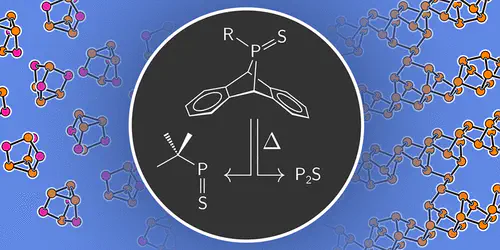Anthracene as a Launchpad for a Phosphinidene Sulfide and for Generation of a Phosphorus–Sulfur Material Having the Composition P2S, a Vulcanized Red Phosphorus That Is Yellow

Abstract
Thermolysis of a pair of dibenzo-7-phosphanorbornadiene compounds is shown to lead to differing behaviors: phosphinidene sulfide release and formation of amorphous P2S. These compounds, tBuP(S)A (1, A = C14H10 or anthracene; 59% isol. yield) and HP(S)A (2; 63%), are available through thionation of tBuPA and the new secondary phosphine HPA (5), prepared from Me2NPA and DIBAL-H in 50% yield. Phosphinidene sulfide [tBuP═S] transfer is shown to proceed efficiently from 1 to 2,3-dimethyl-1,3-butadiene to form Diels–Alder product 3 with a zero-order dependence on diene. Platinum complex (Ph3P)2Pt(η2-tBuPS) (4, 47%) is also accessed from 1 and structurally characterized. In contrast, heating parent species 2 (3 h, 135 °C) under vacuum instead produces an insoluble, nonvolatile yellow residual material 6 of composition P2S that displays semiconductor properties with an optical band gap of 2.4 eV. Material 6 obtained in this manner from molecular precursor 2 is in a poorly characterized portion of the phosphorus–sulfur phase diagram and has therefore been subjected to a range of spectroscopic techniques to gain structural insight. X-ray spectroscopic and diffraction techniques, including Raman, XANES, EXAFS, and PDF, reveal 6 to have similarities with related compounds including P4S3, Hittorf’s violet phosphorus. Various possible structures have been explored as well using quantum chemical calculations under the constraint that each phosphorus atom is trivalent with no terminal sulfide groups, and each sulfur atom is divalent. The structural conclusions are supported by data from phosphorus-31 magic angle spinning (MAS) solid state NMR spectroscopy, bolstering the structural comparisons to other phosphorus–sulfur systems while excluding the formulation of P2S as a simple mixture of P4S3 and phosphorus.